|
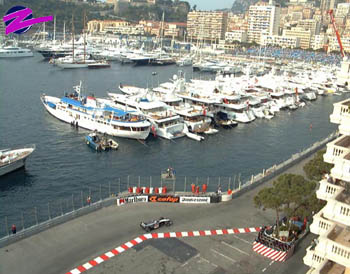 Leaving the circuit by the river, we move to the circuit on the Mediterranean: Monte Carlo. At 3.367 Km, Monaco is the shortest and slowest Grand Prix circuit on the calendar. Monaco claims to be the first ever motor-racing street circuit. Sunday's race will be the 57th Monaco Grand Prix held in 70 years and the circuit is quite similar to the original 1929 circuit. Three-time winner on this circuit, Jackie Stewart, called this "The jewel in the F1 crown." Indeed, it is one of the "Seven Wonders of the Grand Prix World". Leaving the circuit by the river, we move to the circuit on the Mediterranean: Monte Carlo. At 3.367 Km, Monaco is the shortest and slowest Grand Prix circuit on the calendar. Monaco claims to be the first ever motor-racing street circuit. Sunday's race will be the 57th Monaco Grand Prix held in 70 years and the circuit is quite similar to the original 1929 circuit. Three-time winner on this circuit, Jackie Stewart, called this "The jewel in the F1 crown." Indeed, it is one of the "Seven Wonders of the Grand Prix World".
The Monaco Grand Prix used to be called the "Race of 1,000 Corners" when it was run over 100 laps. Since 1973 it has been led over 78 laps but extra corners have been added so there are still almost 1000 corners in this race. The drivers make about 40 gear-changes per lap giving a total of 3120 gear changes, which averages out at 26 gear changes per minute! It comes as no surprise that this circuit is hard on gearboxes and brakes.
The biggest problem is "brain fade", a momentary loss of concentration that has happened to almost all of the current Formula One drivers at some point around this circuit. The point with the highest incidence of brain fade is the first corner, Virage Ste Devote. A large number of drivers have come to grief here. Tabac is another. There are no sand-traps around Monaco and the metal barriers can easily destroy suspension. Nowhere is the old saying "You must first finish before you can finish first" more true.
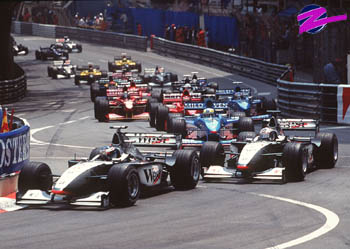 BAR's Team Manager, Greg Field, noted that "You also have to deal with the surface of the circuit being very dirty, It's market day in Monaco on Friday and the roads are re-opened to the public. As a result, there is no chance for the track surface to 'clean up'. The way to a good time around Monaco is generally to get out on the circuit and stay out, and then usually the lap times will come down consistently." BAR's Team Manager, Greg Field, noted that "You also have to deal with the surface of the circuit being very dirty, It's market day in Monaco on Friday and the roads are re-opened to the public. As a result, there is no chance for the track surface to 'clean up'. The way to a good time around Monaco is generally to get out on the circuit and stay out, and then usually the lap times will come down consistently."
Qualifying and securing a good grid position at Monaco is even more important than normal since overtaking is so difficult. That aspect also affects the pit-stop strategy. Wet conditions at Monaco are a possibility, the 1997 race was wet while 1996 race was damp and both races were stopped after two hours.
Pitstops and tyre strategies
Only eleven cars finished last year, all of these finishers adopted a one-stop strategy apart from Tora Takagi, while Michael Schumacher had to make an extra stop to repair accident damage. Ten cars finished in 1997 while only four cars were running at the end of the 1996 race. It would be no surprise if most teams adopted a one-stop strategy on Sunday according to a BAR's Greg Field: "You don't want to get caught behind other cars, and with fuel consumption and tyre wear not really issues on such a slow, tight circuit, most teams are likely to opt for just a single-stop strategy.
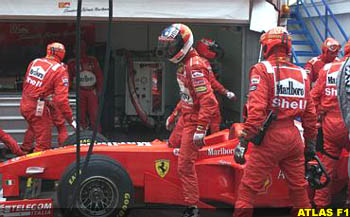 On tyre choice, Mr. Yoshihiko Ichikawa, Technical Manager of Bridgestone Motorsport, stated, "The street circuit character of the course and the smooth surface make Monaco very kind to tyres, because of the slow speeds, aerodynamic loads are low, despite the high downforce wings normally brought out for this one race, and this means that the teams will be seeking to find as much mechanical grip from their cars as they possibly can." On tyre choice, Mr. Yoshihiko Ichikawa, Technical Manager of Bridgestone Motorsport, stated, "The street circuit character of the course and the smooth surface make Monaco very kind to tyres, because of the slow speeds, aerodynamic loads are low, despite the high downforce wings normally brought out for this one race, and this means that the teams will be seeking to find as much mechanical grip from their cars as they possibly can."
Bridgestone will offer teams the option of using its Extra Soft compound tyre as an alternative to the Soft compound tyre. "In testing we have established that the Extra Soft has a tendency to generate more understeer in the handling characteristics of the cars," says Ichikawa. "In addition to taking wear characteristics into consideration, this means that the teams' choice of compound will depend on their ability to dial out the understeer in case they wish to choose the Extra Soft compound." In other words, if your chassis tends to understeer, the soft compound would be a better choice.
The Teams
McLaren is the most successful team in the history of the Monaco Grand Prix, having won there ten times. Their founder, Bruce McLaren, also won there for Cooper in 1962. Do they start as favourites again? They trail Ferrari by twelve points after three Grand Prix. The question marks about reliability, especially in the gearbox, and the unsuccessful strategy at Imola, count against them. As an organisation, McLaren can either identify and solve their problems or look for scapegoats to blame for their problems. Let's hope they choose the former option.
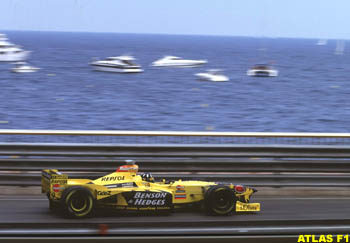 Mika Hakkinen is third equal in the 1999 World Championship. He won last year's race, winning from pole position and setting fastest lap. His manager, Keke Rosberg, is also one of the select few who have won this race. However, 1998 was the only Monaco Grand Prix that Hakkinen has actually finished from seven starts (though he was classified sixth in 1996). Mika Hakkinen is third equal in the 1999 World Championship. He won last year's race, winning from pole position and setting fastest lap. His manager, Keke Rosberg, is also one of the select few who have won this race. However, 1998 was the only Monaco Grand Prix that Hakkinen has actually finished from seven starts (though he was classified sixth in 1996).
David Coulthard is sixth equal in the 1999 World Championship. Coulthard's only finish was a second in 1996. In last year's race he was going well until his Mercedes engine exploded in a cloud of Beryllium dust.
Ferrari must be favourites to win at Monaco. They lead the manufacturers' title chase and have been the most reliable team of 1999. The Ferrari F399 appears to a more forgiving chassis than the McLaren. Ferrari has won the Monaco Grand Prix seven times and a Ferrari 1-2 is not impossible.
The World Championship leader, Michael Schumacher, is the most successful and consistent driver at Monaco since 1994. Schumacher set the lap record for this event in 1994 which still stands today. He has won this Grand Prix three times, matching Jackie Stewart's record. Only Alain Prost, Graham Hill and Ayrton Senna have more wins. He will want to equal Alain Prost's record by winning on Sunday.
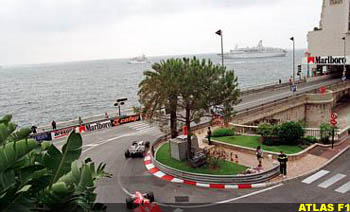 Speaking about Monaco, Schumacher said: "From the mental standpoint, Monaco is probably the toughest there is. There are hardly any straights on which to relax and you have to remain totally concentrated for the entire time. With hardly any run-off areas, even the smallest mistake usually ends in disaster." Speaking about Monaco, Schumacher said: "From the mental standpoint, Monaco is probably the toughest there is. There are hardly any straights on which to relax and you have to remain totally concentrated for the entire time. With hardly any run-off areas, even the smallest mistake usually ends in disaster."
Eddie Irvine is second in the World Championship and he has done consistently well for Ferrari at Monaco. He was third in 1998 and in 1997, although he became the most unpopular driver in Finland in 1996 when both Mika Salo and Mika Hakkinen collided with his stranded Ferrari. "It's a circuit where you should never give up trying," says the Ulsterman. "Even though you might be delayed by some problem and running at the tail end of the field it pays to keep pushing because by the time the chequered flag comes out a lot can happen and you can be back in the points."
Stewart is now fifth in the Manufacturer's championship. Team Owner Jackie Stewart knows how to win at Monaco and his team will be trying to recapture the glory of 1997 when both Stewarts finished with Rubens Barrichello taking second place in the rain. Both Stewarts retired with suspension failure in the 1998 race.
Rubens Barrichello could win at Monaco and is very likely to have a podium finish. Johnny Herbert has yet to finish a race in 1999 but his drive at Imola was very promising. This will be his tenth Monaco Grand Prix. Herbert's best finish was third in 1996 for Sauber and he finished fourth in 1995 for Benetton.
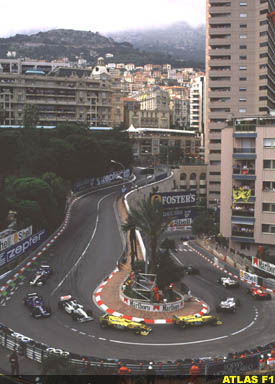 Jordan is third in the manufacturer's championship, however, this team has never gone consistently well at Monaco and last finished in the points in 1997 when Giancarlo Fisichella finished sixth. Last year, Ralf Schumacher and Damon Hill were outclassed. Team owner Eddie Jordan is optimistic "Our reliability has been key to our success so far, and on the streets of Monte Carlo, it will be crucial." Jordan is third in the manufacturer's championship, however, this team has never gone consistently well at Monaco and last finished in the points in 1997 when Giancarlo Fisichella finished sixth. Last year, Ralf Schumacher and Damon Hill were outclassed. Team owner Eddie Jordan is optimistic "Our reliability has been key to our success so far, and on the streets of Monte Carlo, it will be crucial."
Damon Hill has outperformed his father, Graham, in almost all benchmarks but he has never won the Monaco Grand Prix, the race his father won five times. "My first recollection of the Monaco Grand Prix was watching it on the television in 1969," Damon recalled a childhood memory, "I was eight years old, and I was playing in the garden when my mum called out to me, 'Come and watch Daddy winning the Monaco Grand Prix.' That was in fact his fifth victory, but the first one that I can remember."
Hill has finished second for Williams in 1993 and 1995. He was robbed of victory in 1996 when his Renault engine blew up. After a fourth position at San Marino, is Hill's luck changing? This would be a sweet victory for him if he can pull it off.
Heinz-Harald Frentzen is third equal in the World Championship. Frentzen has not gone consistently well at Monaco. He took pole
position in the 1997 race and his best finish was a fourth position for Sauber in 1996, behind his teammate Johnny Herbert. Frentzen, however, is in a positive mood. "You need a huge amount of concentration to race in Monaco and it is a very demanding circuit. It is risky, but that is what makes it so enjoyable. Monaco is definitely the highlight of the F1 calendar," said the German.
Williams is still the best of the Renault/Mecachrome/Supertec-powered set, currently fourth in the manufacturer's championship, but they have under-achieved at Monaco. They have only won this race twice and it has been sixteen years since Keke Rosberg drove a Williams to victory on this circuit. Furthermore, Williams have only scored two points in the last three Monaco Grand Prix.
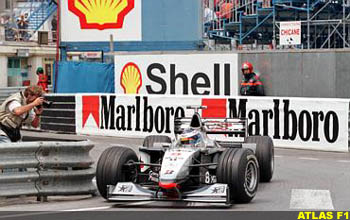 Ralf Schumacher is fifth in the World Championship. He needs to build on his solid start to the season but he has yet to finish at Monaco in two starts. Ralf Schumacher is a Monaco resident who likes his "second home" Grand Prix; "It's good because I don't have to travel, can sleep in my own bed and go to work on my scooter. That is not my only reason for liking Monaco though. Year by year, the Monaco Grand Prix offers a great challenge to all the drivers. Generally it is difficult to overtake in Formula One but here it is impossible if the driver in front of you doesn't want to be passed so qualifying is more important here than anywhere else. I am confident that the Williams team will do a good job." Ralf Schumacher is fifth in the World Championship. He needs to build on his solid start to the season but he has yet to finish at Monaco in two starts. Ralf Schumacher is a Monaco resident who likes his "second home" Grand Prix; "It's good because I don't have to travel, can sleep in my own bed and go to work on my scooter. That is not my only reason for liking Monaco though. Year by year, the Monaco Grand Prix offers a great challenge to all the drivers. Generally it is difficult to overtake in Formula One but here it is impossible if the driver in front of you doesn't want to be passed so qualifying is more important here than anywhere else. I am confident that the Williams team will do a good job."
Alex Zanardi's season is still dogged by cruel luck. Zanardi would be expected to do well at Monaco due to his experience and success on CART street circuits like Long Beach, California, where he won twice. A finish at Monaco would make up for the disappointment at Imola. Zanardi had this to say: "After the first few races it is important for me to have a good race in
Monaco. I'm still trying and at least in Imola I almost got there, the car was running well and I am encouraged. If you say 'I want to win just one race all season', you would say Monaco as there is no doubt that, especially in qualifying, the driver capability in putting that lap together is indispensable. In the race, if you don't have traffic in front of you, if you are able to maintain a certain rhythm, you can really make a lot of difference whereas at other circuits you cannot. It's a pleasure for the driver in front but for the others it can be frustrating if you are sitting behind someone in the race as it is almost impossible to get in front."
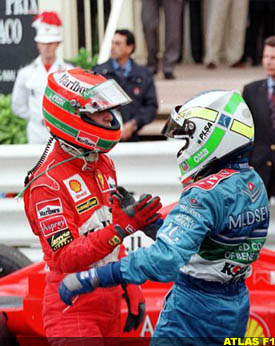 Benetton has done quite well at Monaco over the years. Giancarlo Fisichella finished second last year. Fisichella's fifth place finish at Imola took him to seventh in the driver's championship. Alexander Wurz's performance this season has been well below his great potential. Most of us will remember his spectacular crash last year on the exit to the Loew's tunnel, follow his wheel-banging escapade with Michael Schumacher that weakened his suspension. Benetton has done quite well at Monaco over the years. Giancarlo Fisichella finished second last year. Fisichella's fifth place finish at Imola took him to seventh in the driver's championship. Alexander Wurz's performance this season has been well below his great potential. Most of us will remember his spectacular crash last year on the exit to the Loew's tunnel, follow his wheel-banging escapade with Michael Schumacher that weakened his suspension.
Prost, the Formula One team formerly known as Ligier, has had mixed results at Monaco. Neither Prosts completed the race in 1998, Olivier Panis finished fourth in 1997 and, of course, had that surprise win in 1996 for Ligier. Panis has only finished one race this year, at Interlagos. Jarno Trulli has yet to finish a race this season and has never completed a race at Monaco. Team owner Alain Prost also knows how to win at Monaco having won there on four occasions himself. But, Prost's public complaints about the Peugeot engine do not bode well for the team's relationship with its engine supplier, or for its prospects this weekend.
Sauber's performance at Imola showed that their 1999 car has the potential to be competitive. The unreliability of their gearbox does not bode well for a finish at Monaco. This will be Jean Alesi's tenth Monaco Grand Prix. He finished second in 1990 for Tyrrell in his Monaco debut, was third for Ferrari in 1993 and was fifth in 1994. Alesi led the later stages of the 1996 race and set the fastest lap before his suspension broke. Pedro Diniz scored a single point at Monaco in 1998, finishing sixth.
BAR's fortunes may be improving. Although Ricardo Zonta is still sidelined, his tendon injuries are healing and his car is in the capable hands of Mika Salo. Although they have had no finishes in three starts, Mika Salo nearly made it to the chequered flag at Imola. Jacques Villenueve's fifth position on the grid at Imola for was an outstanding achievement.
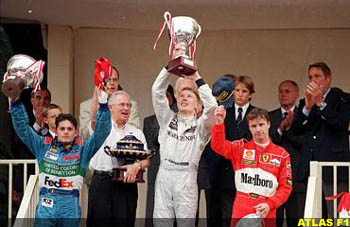 Villeneuve, like Damon Hill, has outperformed his own father in almost all benchmarks but he has never won the Monaco Grand Prix, the race Gilles Villenueve won in 1981. Jacques Villenueve's only finish at Monaco was fifth in 1998 from three starts. Villenueve, like Zanardi, could do well at Monaco if he had a competitive car, due to his CART experience on street circuits. Mika Salo will have another chance to demonstrate his talent in Zonta's car on Sunday. Mika Salo has gone consistently well at Monaco in uncompetitive cars, finishing fourth in 1998 and was fifth in 1997 and 1996. Villeneuve, like Damon Hill, has outperformed his own father in almost all benchmarks but he has never won the Monaco Grand Prix, the race Gilles Villenueve won in 1981. Jacques Villenueve's only finish at Monaco was fifth in 1998 from three starts. Villenueve, like Zanardi, could do well at Monaco if he had a competitive car, due to his CART experience on street circuits. Mika Salo will have another chance to demonstrate his talent in Zonta's car on Sunday. Mika Salo has gone consistently well at Monaco in uncompetitive cars, finishing fourth in 1998 and was fifth in 1997 and 1996.
Salo recently commented, "I don't know why I've tended to go well at Monaco in recent years, I love the atmosphere there during Grand Prix week and I really enjoy the driving precision and concentration that is required by such a demanding street circuit, so maybe it's just because I have been able to go into the event feeling relaxed and with a 'nothing-to-lose' kind of attitude. Monaco is often full of surprises. It would be great to get the team's first points."
Arrows need to finish. With the high rate of attrition, a finish in the points for either Pedro de la Rosa or Tora Takagi is not impossible - Both Arrows cars finished in the points last year while Takagi finished the race for Tyrrell.
Minardi, like Arrows, need to finish. Since at least half the field is likely to retire, finishing at Monaco is everything. Unfortunately, Mark Gene is a novice and Luca Badoer has yet to finish a race at Monaco himself.
My Predictions:
In the event of rain, anything can happen at Monaco so it would be rash even to suggest a finishing order. If it is dry, I'm going to stick my neck out and pick Ferrari, McLaren and Stewart as the top three teams.
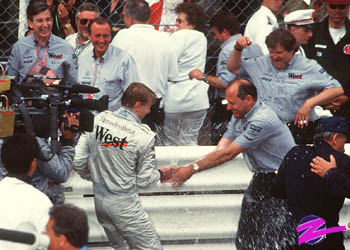 Starting grid:
Starting grid:
1. Michael Schumacher
2. Mika Hakkinen
3. David Coulthard
4. Eddie Irvine
5. Rubens Barrichello
6. Johnny Herbert
7. Damon Hill
8. Heinz-Harald Frentzen
9. Ralf Schumacher
10. Jacques Villeneuve
11. Alex Zanardi
12. Giancarlo Fisichella
13. Olivier Panis
14. Mika Salo
But in the end it is all down to care, reliability, luck - and "brain-fade".
| 
